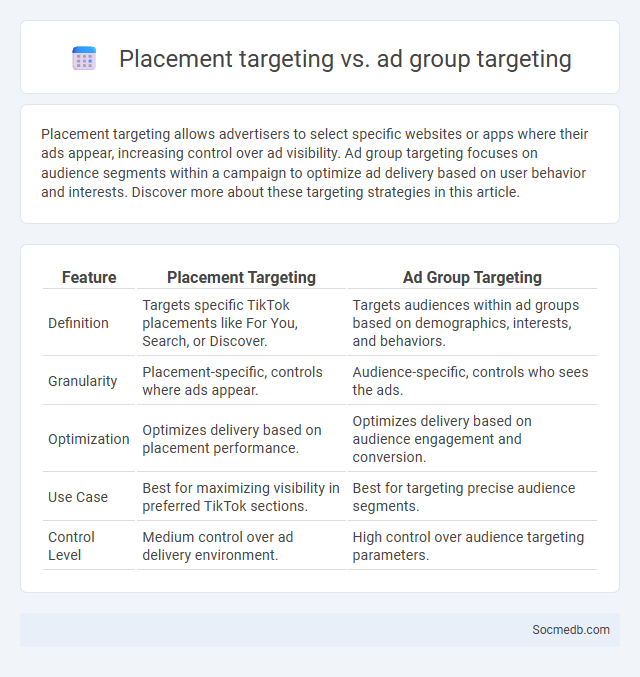
Photo illustration: Placement targeting vs Ad group targeting
Placement targeting allows advertisers to select specific websites or apps where their ads appear, increasing control over ad visibility. Ad group targeting focuses on audience segments within a campaign to optimize ad delivery based on user behavior and interests. Discover more about these targeting strategies in this article.
Table of Comparison
| Feature | Placement Targeting | Ad Group Targeting |
|---|---|---|
| Definition | Targets specific TikTok placements like For You, Search, or Discover. | Targets audiences within ad groups based on demographics, interests, and behaviors. |
| Granularity | Placement-specific, controls where ads appear. | Audience-specific, controls who sees the ads. |
| Optimization | Optimizes delivery based on placement performance. | Optimizes delivery based on audience engagement and conversion. |
| Use Case | Best for maximizing visibility in preferred TikTok sections. | Best for targeting precise audience segments. |
| Control Level | Medium control over ad delivery environment. | High control over audience targeting parameters. |
Understanding Placement Targeting
Placement targeting in social media allows you to specify where your ads appear, such as within users' feeds, stories, or specific apps and websites across the platform's network. This method enhances ad relevance by reaching your audience in contexts where they are most engaged, increasing the likelihood of interaction and conversion. Optimizing your social media strategy with precise placement targeting ensures your marketing budget delivers maximum impact by connecting with your ideal customers in preferred digital environments.
What Is Ad Group Targeting?
Ad group targeting allows you to organize your social media advertising campaigns by grouping ads with similar themes and targeting criteria. This method improves the relevance and effectiveness of your ads by focusing on specific demographics, interests, or behaviors within each group. By using ad group targeting, you can optimize your budget allocation and measure performance more accurately for better campaign results.
Explaining Audience Targeting
Audience targeting in social media involves identifying and reaching specific groups based on demographics, interests, behaviors, and geographic locations to maximize engagement and conversion rates. Platforms like Facebook, Instagram, and LinkedIn use advanced algorithms and user data to enable precise ad delivery aimed at the most relevant audience segments. Effective audience targeting improves campaign performance by delivering personalized content that resonates with users' needs and preferences.
Key Differences Between Targeting Methods
Targeting methods on social media primarily differ by audience specificity and data sources, including demographic, behavioral, and interest-based targeting versus lookalike and custom audience targeting. Demographic targeting uses age, gender, and location data, while behavioral targets users based on their actions, such as previous purchases or engagement with content. Lookalike audiences leverage machine learning to find users similar to existing customers, offering higher precision, whereas custom audiences focus on retargeting known users through CRM data or website visits.
Benefits of Placement Targeting
Placement targeting on social media enables advertisers to reach specific audiences by displaying ads on selected platforms, pages, or content types, improving ad relevance and engagement rates. This targeted approach increases conversion opportunities by aligning marketing messages with user interests and behaviors, resulting in higher ROI. By utilizing placement targeting, brands gain greater control over ad spend and can optimize campaigns for maximum performance across various social channels.
Advantages of Ad Group Targeting
Ad group targeting in social media enhances campaign precision by allowing marketers to segment audiences based on specific demographics, interests, and behaviors, resulting in higher engagement rates. This targeted approach improves ad relevance and lowers cost-per-click (CPC) by delivering content tailored to user preferences. Optimizing ad groups also facilitates better performance tracking and budget allocation, maximizing return on investment (ROI) for social media campaigns.
Strengths of Audience Targeting
Social media platforms offer powerful audience targeting capabilities by leveraging detailed demographic, behavioral, and interest data to deliver highly relevant content and advertisements. These strengths enable marketers to optimize ad spend, increase engagement rates, and drive higher conversion through precise segmentation and retargeting strategies. Sophisticated algorithms and real-time analytics further enhance targeting accuracy, allowing continuous campaign refinement based on user interactions.
When to Use Each Targeting Strategy
Use demographic targeting on social media to reach specific age groups, genders, or income levels for product launches or localized promotions. Employ interest-based targeting to engage users whose behaviors and preferences align with niche markets, enhancing campaign relevance. Leverage behavioral targeting to retarget users who have interacted with your content, boosting conversion rates through personalized ads.
Combining Targeting Methods for Best Results
Combining targeting methods such as demographic, behavioral, and interest-based criteria on social media platforms enhances ad relevance and audience engagement, leading to higher conversion rates. Utilizing tools like Facebook's Custom Audiences alongside lookalike targeting maximizes reach while maintaining precision. Integrating data-driven insights from analytics further optimizes campaign performance by refining audience segments and minimizing ad spend waste.
Choosing the Right Targeting for Your Campaign
Choosing the right targeting for your social media campaign involves analyzing audience demographics, interests, and behaviors to ensure precise ad delivery. Utilizing platform-specific tools like Facebook Audience Insights or LinkedIn Campaign Manager can optimize reach and engagement by focusing on high-value segments. Refining your targeting based on performance data enhances conversion rates and maximizes return on investment (ROI).
 socmedb.com
socmedb.com